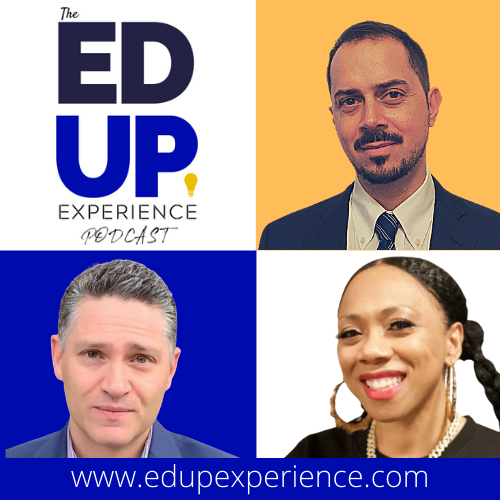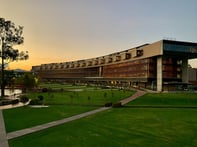Published on
Community Colleges are the First-Choice College

Community colleges have long had a stigma of being low quality. With the pandemic highlighting the need for skilled workers, community colleges have been presented with an opportunity to shine. In this interview, Dr. Joe Sallustio and Liz Leiba speak to Michael Baston about the equitable realities of some communities, the importance of serving underrepresented students and what the future of the community college looks like.
EdUp Experience: Why do you think community college has been stigmatized, and what’s being done to change that?
Michael Baston (MB): Those who tell the story are the ones for whom the story is distributed. So, if you have a lot of people who didn’t go to community college and decide on higher education’s narrative, you’re not going to hear many of stories about us. If folks actually own the fact that they started in a community college and bring that to the forefront beyond the other credentials that they may have, then you’ll get more of the stories of hope, aspiration and inspiration. But what I have found is that this caste system has been created through transfer policies that are articulate transfer articulation policies, that have been created in a whole myriad of ways. What the country understands now is that the community college continues to be the first choice for those who want to get a quality education at a price they can afford.
Edup Experience: What are some of your recommendations or strategies for serving underrepresented communities?
MB: Meeting students at their level of preparation is what we are particularly good at. We actually educate the top 100%, which means that we’re providing support according to the needs of each student. So, if you need more in the way of formative support, we’re going to provide it for you. But one of the things that I think we’re doing particularly well, especially over these last five to ten years is really developing these guided pathways, how we’re helping students engage at the beginning of their educational journey in career exploration and development, so they can get on an academic program or path that, when monitored and supported, they can complete and jump off from to transfer institutions or, for many, the world of work that pay a family’s living wage.
So, it’s very important for us not to build bridges to nowhere. It doesn’t help me to have a student living study in an academic program that’s going to keep them in poverty. That makes no sense. We really are looking to develop the kind of academic programs that are linked to destinations and experiences that make achieving that destination possible. What does your economic situation in your region call for? What kinds of professionals do you need, and how are you ensuring that the educational experience is melded with out-of-the-classroom experiences, so students are competitive in a professional environment. It is very important for us to recognize that our colleges are models of this new, higher-level integration with community-based organizations and business and industry.
EdUp Experience: What are some effective strategies for creating meaningful partnerships?
MB: Just think about the K-to-12 partnership as an example of how we work to develop a STEM school within the community college and connect it to P-TECH, which is a high school program that prepares students of color, mostly first-generation, who would not see a career in the sciences as an option for them. We could partner with that local P-TECH, bring those students into a four-year institution, at the school of science, engineering or technology, so they can get the high-wage, high-opportunity jobs within the region.
So it is that kind of very intentional connection, looking at the equitable realities of your community. My P-TECH is in a community where there’s a lot of financial fragility. It’s important to get disadvantaged students, turning them on to science, bringing them into our STEM and then getting them into a four-year school or a job. So, we can’t speak in abstract terms; we have to speak in very real concrete terms. And that is an example of how institutions who are really forward-thinking can look at a community issue, which is poverty, and build a bridge between that chasm.
EdUp Experience: How much do you focus on college prep, and what are the opportunity gaps for students when they’re not as prepared as they should be?
MB: Well, part of it is recognizing the importance of dual enrollment opportunities. The unfortunate fact is that dual enrollment is not always an equitable proposition. So, you have high performing folks, who are likely better supported, who get into these dual enrollment programs, but you have low-income folks who could benefit from dual enrollment programs to build the necessary skill levels to do college-level work while they’re in high school, and these programs exist but we are not getting enough people of color involved and providing them with the additional support they need to move toward a future they deserve. We also have to think about the possibility of bootcamps, and how we get people into the pipeline from the K-to-12 system. But we can’t stop at K to 12, because we have a lot of folks who have some college and no degree. A lot of folks worked in an industry before the pandemic that no longer exists, and they need to get a job. Well, how are they going to get back into the stream of opportunity if they’ve been out of college for 20 years or only picked up a few credits? How are we engaging them in credit for prior learning? They have experienced things for which they should be able to get some kind of credit that then could earn them shorter-term credentials or get them back into college in a flexible kind of arrangement, so they have a chance to change the trajectory of their life.
EdUp Experience: What are some of the things that we can do to be more responsive, so we can quickly get our students to hit the ground running?
MB: First and foremost, the federal government does not provide short-term PLA. So, even if you have the shorter-term credential that would give somebody access to the world of work to get into hot fields, they can’t afford them. Particularly if you’re a student that comes to the community college, there could be some economic fragility issues.
If you’re going for the shorter-term credential to get right into the workforce and earn a higher wage, the federal government doesn’t support that from a financial aid perspective. But if poorer people could access shorter-term programs that lead them to a family-supporting wage and then allow them to return at a later point in their journey, to the longer-term credential that would lead them to even higher wages, that would make a huge difference. And so, that is why you get a lot of people who question how they can move this forward.
So, what do colleges do in light of the fact that you can’t do the short-term PLA? You can’t often provide the money for students to get these shorter-term credentials, so you provide microcredentials. We try to embed within the academic program the additional credentials that would make students employable if they had to stop out. You can embed it through the co-curriculum. You can actually make sure that students access experiences that become part of their co-curricular transcript, or they can get digital badges, but some way to document that they acquired skills.
EdUp Experience: How can we get parents and students to understand that community college isn’t just for working moms or adult learners?
MB: The issue is less students and more parents. Parents like to go to the cookout in the summer to tell your friends where Johnny and Janie are going off to school, put the pressure on them to go places that are not necessarily good for them, for your friends, but for those young people, they do need a place that has smaller class sizes. And they do, particularly if some parents are requiring the student to pay for their own college, many of the students are actually going to be thinking about how they can get credit while they’re at a high school so that they don’t have to pay big bills, how they can get an honors programs so that they could get to the higher tier colleges without the higher tier college price.
Then you think about the fact that more than 40% of the folks that are baccalaureate students started at a community college. What happens is that parents don’t really recognize how many of your neighbor’s children actually started at the community college. I think that we got to get the message out to parents, not so much the students, because more and more students are making the community college, the college of choice, because they don’t want the loans, because their friends or because they took the classes in high school and now can complete quicker. The students are starting to see the value proposition in ways that the parents haven’t caught up with, to be honest.
Edup Experience: What are students telling you right now about what kind of experience—online or hybrid—they want?
MB: The bottom line is, the reason why a lot of our students come to community college is because they don’t want a correspondence course. And so for those folks who say, oh, well, we have to offer everything online now all the time, a lot of people who come to the community college, that’s not the modality that they want. They want to be in a smaller class where they can talk to people, that they can have a relationship with their teacher, that they can have a relationship with their peers. They don’t want to study at home because many of them can’t study at home. So they need to be in a study space and in an environment that’s conducive to focusing on the task at hand when they’re in school.
What we’re seeing is that some of the students have said, I’ll come back when you come back. You’ll see that some of the declines in enrollment across the spectrum say, well, some people are saying, we’ll come back when you come back. So our hope is that the more people can get vaccinated, the more people can maintain the appropriate prerogatives, making sure that you’re taking care of yourself, washing your hands and wearing masks and so on and so forth. The way that we stop the spread of the disease and get people back on campus, I think you will see more people heading back to the community college.
Now that it’s now, some are not afraid of being in a virtual environment. So I think more students might want a hybrid experience so that they can pick the classes that they want to be in, in a virtual environment, such that it comports with their work or life schedule, but I think still the majority of the community college students will want to be in that face-to-face, small class, communal setting, where they have a sense of place within that environment.
EdUp Experience: What are some of the things that you’ve done on your campus to support marginalized, first-generation students and what tips do you have?
MB: One very important thing is working with the superintendents, because we recognize that the challenges they have are our challenges too, and not deciding that that’s their problem. It’s our collective opportunity to really become much more seamless in our work together to keep the students within a pipeline of opportunity. I think that is extraordinarily important to work with superintendents in your community. I think one of the other things is to engage in the kind of comprehensive virtual support services that students need. Before the pandemic, we didn’t have 24 hour tutoring center. We didn’t have 24 hour mental health. We didn’t have virtual testing centers. We didn’t have academic and career advisement in a significant way in a virtual environments. We didn’t have any of these sorts of things.
Now as a result of the pandemic, not only do we have them, but they will remain with us long after the pandemic has gone, that provides a demonstrably support to these populations that you’re talking about, who can’t necessarily engage in support services between 9:00 and 5:00, who ultimately don’t have the luxury of turning on their camera in their home while the class is going on. It’s those kinds of things that we got to be thinking about in terms of how do we reset expectations around our more 24/7 on demand kind of support access to support structure. That’s going to be very, very important.You also have to make sure that you have your folks with the kind of professional development that enables them to teach in different modalities. You have to have the electronic capability, the bandwidth, if you will, to provide the support of access in real meaningful ways. And that has to be irrespective of whether you’re in urban areas, suburban areas or rural areas.
EdUp Experience: You have a big campus. Do you look at facilities and go, if we have hybrid learning, we’ve got too many facilities, not enough facility, what does that do, or if anything to your financial model plans?
MB: Well, ultimately what we should be thinking about is how do we use what we have in more effective ways and how do we partner if there are others that can participate in the utilization of facilities and gain financial opportunity for both groups. And so we are very, very careful about, we had already had a space challenges before. We’re not going to put everybody in the virtual environment as a means of freeing up space. Because as I say, for many community college students, the correspondence course model doesn’t work for them.
So we need to be thinking about different kinds of scheduling, we have to think about, how does the schedule control the way in which we utilize the physical infrastructure? And I think that what this pandemic has done for us is to say that the traditional notions of the Carnegie hour and how you use it in the schedule or how it’s used, all of that stuff goes out the window. There are no snow days anymore for us.
We can be a little bit more creative than we have been because we’ve been bound by rules that we were able to see through this experience should be now no longer sort of those, what I would call those gatekeeper moments of innovation. I don’t want innovation to be blocked by gatekeepers. I want innovation to be spread through us being a gateway for opportunity.
EdUp Experience: Is there anything that you want to add, and what do you see as the future for higher education?
MB: We’ve engaged in what we call steps beyond statements. And we are leaning very, very far in to ensure that we address structural racism through educational transformation. How do we use education to challenge unconscious bias, to challenge the unchallenged narratives in higher education and in society in general. And I’m really proud of the fact that we are improving our employee experience and doing it with an equity lens by gathering people into the conversation and giving people a voice so that they can make our institutions strong.
I encourage all educational institutions to look at their practices and determine what equitable reforms need to take place. Because when we, as institutions, make part of our mission preparing those citizen, educated citizens, we then will see how our world can get better, how our world can get brighter, how we can have a much more just union. And so I believe it’s incumbent upon every educator to participate in helping our country get moving in the direction of appropriate equitable outcomes for all students. And I hope that that is a future we all believe in and we’ll work hard to secure.
This interview was edited for length and clarity.
Listen to the full interview here.

Disclaimer: Embedded links in articles don’t represent author endorsement, but aim to provide readers with additional context and service.
Author Perspective: Administrator
Author Perspective: Community College



